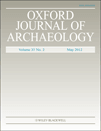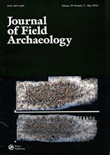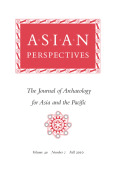
Baltica
Scope & Guideline
Advancing Knowledge in Earth and Planetary Sciences.
Introduction
Aims and Scopes
- Archaeological Research:
The journal emphasizes archaeological discoveries and methodologies, showcasing studies that analyze artifacts, settlement patterns, and burial practices across different historical epochs. - Cultural Heritage Studies:
A core area of focus is the exploration of cultural heritage, including the impacts of socio-cultural changes on communities, as well as the preservation and interpretation of archaeological sites. - Environmental and Subsistence Studies:
Research on ancient diets, subsistence strategies, and interactions with the environment, particularly through isotopic analysis and material studies, is a significant aspect of the journal's contributions. - Material Culture Analysis:
The journal includes detailed examinations of material culture, such as pottery, metalwork, and other artifacts, assessing their typology, chronology, and socio-cultural implications. - Interdisciplinary Approaches:
'Baltica' encourages interdisciplinary methodologies, integrating archaeology with other fields such as history, anthropology, and environmental science to provide a holistic understanding of the Baltic region's past.
Trending and Emerging
- Isotopic Analysis and Diet Reconstruction:
Recent publications have increasingly employed stable isotope analysis to reconstruct ancient diets, indicating a growing interest in understanding subsistence strategies and environmental adaptations in historical populations. - Interdisciplinary and Technological Approaches:
The incorporation of advanced technologies, such as portable X-ray fluorescence for material analysis, demonstrates a trend towards interdisciplinary methodologies that enhance the reliability and depth of archaeological research. - Focus on Prehistoric and Early Historical Periods:
There is a notable trend towards exploring prehistoric and early historical periods, particularly the Late Bronze Age and Iron Age, reflecting a desire to understand foundational cultural developments in the Baltic region. - Cultural Heritage and Community Engagement:
Emerging themes also include a focus on cultural heritage and its significance to contemporary communities, emphasizing the relevance of archaeological findings in modern societal contexts.
Declining or Waning
- Classical Antiquity Studies:
Research focusing on classical antiquity, particularly the Roman period, has seen a decrease, indicating a potential shift towards earlier and more localized archaeological contexts. - Urban Archaeology of Early Modern Periods:
The exploration of urban development and archaeological findings from early modern periods, while still present, appears less frequent compared to the increasing focus on prehistoric and early historical contexts. - Traditional Artifact Typologies:
There seems to be a waning interest in traditional typological studies of artifacts, as the journal shifts towards more innovative analytical methodologies and interdisciplinary approaches.
Similar Journals

Stratum Plus
Exploring the Depths of Humanity and TimeStratum Plus, published by HIGH ANTHROPOLOGICAL SCH UNIV, is a distinguished academic journal based in Moldova that focuses on the fields of Anthropology, Archeology, and History. With an impressive impact factor reflecting its stature—ranked in the Q2 category for both Anthropology and Archeology, and Q1 for Archeology in the arts and humanities—this journal is a vital resource for scholars, professionals, and students alike. The journal's comprehensive scope encompasses a wide array of interdisciplinary studies, making it a beacon for innovative research and critical discourse within these disciplines. Since its inception in 2014, Stratum Plus has strived to foster academic excellence and knowledge dissemination, thus playing a crucial role in shaping contemporary anthropological and archaeological thought. While currently not available as Open Access, the journal maintains a strong online presence, with access options available through institutional subscriptions. Located at ZIMBRULUI 10A ST, KISHINEV MD-2024, MOLDOVA, Stratum Plus invites contributors and readers to engage with cutting-edge research that continues to enrich the global academic community.

Oxford Journal of Archaeology
Connecting Scholars, Inspiring DiscoveriesOxford Journal of Archaeology is a prestigious peer-reviewed journal published by WILEY, dedicated to advancing the field of archaeology through innovative research and insightful discourse. Established in 1982, this journal has become a vital resource, showcasing high-impact studies that resonate within the arts and humanities, as well as interdisciplinary fields such as geography and planning. With an impressive Q1 ranking in both Archaeology and Arts & Humanities categories, and a Q2 ranking in Geography, Planning, and Development, the journal consistently maintains its reputation for excellence—evidenced by its ranking in the 81st percentile within the Scopus Arts and Humanities Archaeology category. The Oxford Journal of Archaeology not only provides scholars, professionals, and students with access to cutting-edge archaeological research but also encourages collaboration and dialogue among a diverse academic community. Although the journal does not currently offer Open Access, it remains a crucial platform for those seeking to expand their knowledge and impact in this dynamic field.

Kratkie Soobshcheniya Instituta Arkheologii
Pioneering Insights in the HumanitiesKratkie Soobshcheniya Instituta Arkheologii is a prestigious academic journal published by IZDATELSTVO NAUKA, specializing in the fields of archaeology and history. With an ISSN of 0130-2620, this journal has established itself as a vital resource for scholars, researchers, and students engaged in the humanities, particularly within the Russian Federation. Recognized for its high-quality contributions, it has achieved a remarkable Q1 ranking in both Archaeology and History for the year 2023, demonstrating its significant impact and relevance in these disciplines. Although it does not provide open access, the journal's robust positioning in Scopus — ranking #634 in History and #208 in Archaeology — further attests to its scholarly authority and the insightful research it disseminates. The journal covers a comprehensive range of topics, facilitating a deeper understanding of archaeological practices and historical methodologies, thereby fostering academic dialogue and knowledge advancement from 2018 through 2024. Addressing an international audience of professionals and students alike, Kratkie Soobshcheniya stands as a cornerstone for innovative research in archaeology and history.

Journal of Pacific Archaeology
Illuminating the Past, Shaping the Future of the PacificThe Journal of Pacific Archaeology, published by the New Zealand Archaeological Association, serves as a pivotal platform for disseminating cutting-edge research in the field of archaeology across the Pacific region. With an ISSN of 1179-4704 and an E-ISSN of 1179-4712, the journal provides a forum for scholarly discourse aimed at both established researchers and emerging scholars alike. Focusing on the rich tapestry of archaeological studies, it covers a diverse array of topics, from ancient settlement patterns and cultural practices to contemporary analyses of material culture. As an Open Access journal, it ensures that its findings are readily available to all, fostering inclusivity in academic research and enabling practitioners to share knowledge without barriers. The Journal of Pacific Archaeology is indispensable for those committed to understanding the complexities and nuances of Pacific archaeology, making significant contributions to both regional and global archaeological narratives.

ZEITSCHRIFT FUR AGYPTISCHE SPRACHE UND ALTERTUMSKUNDE
Illuminating Egypt's Linguistic and Cultural HeritageZEITSCHRIFT FUR AGYPTISCHE SPRACHE UND ALTERTUMSKUNDE, published by Walter de Gruyter GmbH, is a preeminent journal in the field of Egyptology, archaeology, and history. With roots tracing back to 1863, the journal has made significant contributions to the understanding of ancient Egyptian language and culture through rigorous scholarship and a commitment to academic excellence. The journal is subscribed to both print and digital formats, offering comprehensive access to a diverse range of critical research articles and reviews that appeal to researchers, students, and professionals alike. Presenting a unique blend of linguistic, historical, and archaeological perspectives, the journal has maintained a steady presence in academia despite fluctuating publication periods. In 2023, it ranks in the Q3 and Q4 quartiles across multiple categories, emphasizing its relevance and ongoing contributions to the understanding of ancient civilizations. Researchers looking to dive deep into the intricacies of Egypt's linguistic heritage and cultural contexts will find this journal an invaluable resource.

JOURNAL OF FIELD ARCHAEOLOGY
Advancing Discoveries, Connecting Past and PresentJOURNAL OF FIELD ARCHAEOLOGY, published by Routledge Journals, Taylor & Francis Ltd, is a premier scholarly publication dedicated to advancing the field of archaeology. With an impressive impact factor reflecting its significant contributions to both the arts and humanities, this journal ranks in the Q1 category for archaeology, with a remarkable position of #21/413 in the arts and humanities realm and #19/354 in social sciences, placing it in the 95th percentile among its peers. Catering to researchers, professionals, and students alike, the journal has continuously explored critical archaeological questions since its inception in 1974, with a commitment to disseminating high-quality research and innovative methodologies up to the present. Although it operates under a traditional access model, the journal engages a broad readership with its insightful studies and findings, making it an essential resource for anyone deeply involved in archaeology and its related disciplines.

Asian Perspectives-The Journal of Archaeology for Asia and the Pacific
Illuminating Cultures: A Journey through Time and SpaceAsian Perspectives - The Journal of Archaeology for Asia and the Pacific is a prestigious journal published by University of Hawaii Press, focusing on the intricate field of archaeology in Asia and the Pacific. With a rich publication history dating back to 1993, the journal has established itself as a vital platform for disseminating research that illuminates the archaeological heritage and cultural dynamics of this diverse region. Recognized for its scholarly impact, it enjoys a commendable impact factor and ranks in the Q2 category for Anthropology and Archaeology, indicating its significant contribution to these fields. Although it operates on a traditional subscription-based model, the journal is accessible to institutional and individual subscribers worldwide. With an emphasis on interdisciplinary research, Asian Perspectives invites contributions that foster a deeper understanding of historical and contemporary issues through archaeology, making it an invaluable resource for researchers, professionals, and students alike committed to advancing scholarly dialogue in the region. Explore a wealth of innovative studies and insights that continue to shape the understanding of Asia and the Pacific's archaeological narrative.

Southern African Humanities
Bridging past and present in Southern African studies.Southern African Humanities is an esteemed academic journal published by the Natal Museum, dedicated to advancing the fields of anthropology, archaeology, and cultural studies with a particular focus on the Southern African context. Since its inception in 2008, the journal has consistently provided a platform for innovative research and scholarly discourse, earning a prominent reputation with a 2023 impact factor that places it in the Q2 and Q1 quartiles across multiple relevant categories, including Anthropology, Archaeology, and History. The journal is recognized for its rigorous peer-review process and dissemination of high-caliber research, exemplified by its Scopus rankings, which reflect its widespread influence within the humanities. Although it does not currently offer open access options, the journal remains pivotal for researchers, professionals, and students aiming to deepen their understanding of Southern African cultures and historical contexts. Located in Pietermaritzburg, South Africa, Southern African Humanities continues to be an essential resource for those engaged in the humanities, enhancing knowledge and fostering research collaborations within the region and beyond.

Annales Instituti Archaeologici
Advancing Archaeological Knowledge Through Rigorous ResearchAnnales Instituti Archaeologici is a distinguished journal published by INST ARHEOLOGIJU, dedicated to advancing research in the field of archaeology. With an ISSN of 1845-4046 and an E-ISSN of 1848-6363, this journal serves as a vital platform for the dissemination of innovative archaeological studies and findings, reflecting the evolving trends and methodologies in this fascinating discipline. Based in Croatia, the journal captures a global audience, emphasized by its Q3 ranking in both Archaeology categories as per the latest 2023 metrics, indicating a solid presence in the academic landscape. Although it does not currently offer Open Access options, its impactful contributions are recognized through its Scopus ranks, where it stands at #137/413 in Archaeology related to Arts and Humanities and #135/354 in Social Sciences. Researchers, professionals, and students interested in the latest archaeological research and its applications will find Annales Instituti Archaeologici to be an invaluable resource, promoting knowledge and fostering scholarly communication within the archaeological community.

Origini
Connecting Scholars to the Rich Tapestry of Human History.Origini is a distinguished journal dedicated to the field of archaeology, published by EDIZIONI QUASAR S TOGNON SRL in Italy. With an ISSN of 0474-6805, it offers a platform for researchers and professionals to share their latest findings and insights. Having achieved a significant Q2 ranking in both Archaeology (Arts and Humanities) and Archaeology (Social Sciences) categories according to Scopus, it positions itself as a respected source of scholarly communication in the discipline. Over the converged years from 2017 to 2023, Origini has consistently aimed to advance archaeological research, fostering an environment where innovative theories and methodologies can be developed and discussed. Although it is not an Open Access journal, its contributions remain vital for academics and students seeking to deepen their understanding of archaeological practices and historical narratives. With a commitment to excellence, Origini stands as an essential resource within the archaeological community, inviting contributions that push the boundaries of knowledge and interpretation.